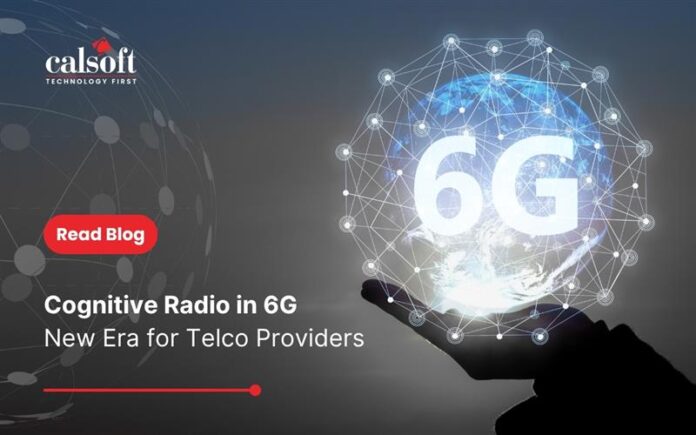The telecommunications industry is standing on the edge of a fundamental transformation. While 5G deployment continues globally, research and early testbeds for 6G are already redefining what is possible in wireless communication. One of the most significant shifts in this next-generation journey is the integration of Cognitive Radio (CR) into the core fabric of 6G architecture, becoming a critical component of future 6G wireless networks.
CR introduces real-time intelligence, spectrum adaptability, and autonomous decision-making, making it essential for next-gen telecom infrastructure. As telcos face growing pressure from data-heavy applications, ultra-low latency demands, and spectrum scarcity, Cognitive Radio will play a central role in staying competitive.
Read the blog to learn how Cognitive Radio is shaping the future of 6G networks and what it means for telecom providers.
From Static Spectrum to Dynamic Intelligence
The traditional approach to spectrum allocation—fixed licenses and static frequency bands—is unsustainable in the era of exponential device growth and bandwidth-intensive applications like XR, holographic calls, and digital twins. CR disrupts this paradigm.
First introduced by Joseph Mitola in the late 1990s, Cognitive Radio is a self-aware radio system that senses its RF environment in real-time and dynamically adjusts its transmission parameters. This means idle or underutilized spectrum can be temporarily accessed by secondary users without disrupting primary license holders—a concept we now refer to as Dynamic Spectrum Access (DSA).
This model brings direct business benefits by helping Communication Service Providers (CSPs) tap into underutilized spectrum, allowing them to onboard more users without additional licensed bands—lowering cost-to-serve while expanding market reach.
The rise of Software Defined Radios (SDRs) has already paved the way, offering the reconfigurability needed to support CR functionality. With integrated sensing and communication (ISAC) and AI-native frameworks in the mix, spectrum use becomes fully autonomous, context-aware, and highly efficient.
Calsoft brings deep expertise in telecom through its dedicated Networking & Telecom Center of Excellence. The team supports end-to-end transformation—spanning legacy systems to modern, cloud-native architectures—across network automation, SDN, NFV, and edge deployments.
Read the eBrief to understand the significance of intelligent Radio Access Network (RAN)
Intelligent RAN automation
Cognitive Radio in 6G: Why Now?
So why is CR becoming central to 6G—and why should telco leaders care?
- Spectrum scarcity is real. As frequencies above 100 GHz are being explored for 6G (e.g., terahertz bands), traditional spectrum management strategies break down. CR enables more granular, fine-tuned usage based on demand, location, interference patterns, and application priorities. Terahertz bands (0.1–10 THz), with their ultra-high bandwidth potential, open up new frontiers for real-time sensing, ultra-high-speed data, and sub-millisecond latency applications—making CR essential to manage their complexity and propagation challenges.
- AI-native architectures demand smarter infrastructure. Frameworks like O-RAN’s RIC and 3GPP’s AI workgroups are pushing for embedded intelligence across the RAN. CR integrates naturally into this vision by using ML models to optimize channel selection, power control, and modulation in real time. This also complements the core 5G pillars—massive IoT, ultra-low latency, and enhanced mobile broadband—by enabling dynamic spectrum allocation based on live bandwidth needs.
- Cost-to-serve must drop. Telcos cannot keep adding fixed infrastructure to solve performance gaps. CR-based systems promise better utilization of existing infrastructure through adaptive beamforming, environment-aware routing, and interference mitigation—improving quality of service without proportional capex.
Use Cases Already Emerging
Some of the most compelling CR applications for 6G include:

- Ultra-dense urban networks: In environments where spectrum is congested, CR can dynamically offload traffic based on real-time availability across frequency, time, and spatial dimensions.
- Private networks for enterprise/industrial use: CR allows tailored spectrum slices for mission-critical apps, especially where licensed spectrum access is restricted.
- Remote and underserved regions: CR can facilitate opportunistic spectrum sharing to provide connectivity where traditional network rollouts are infeasible or economically unviable.
- Integrated Sensing & Communication (ISAC): CR pairs naturally with ISAC in 6G, enabling radios not just to communicate but to perceive—detecting movement, interference, or environmental changes and adapting transmission behaviour accordingly.
For instance, CR setups can forecast signal loss due to weather conditions like rain, fog, or snow, dynamically adapting power and frequency to reduce packet drops and maintain a consistent user experience.
Strategic Challenges Ahead
Despite the promise, there are key challenges telco leaders need to address:


- Standardization & interoperability: Without clear global CR standards, especially for AI-native RIC integration, adoption will remain fragmented.
- Security and control: Autonomous radios making real-time decisions introduce new threat vectors. Ensuring robust authentication, access control, and fail-safes will be critical.
- Model explainability: As AI drives more of the radio’s decisions, telcos must ensure transparency in these models, particularly for regulatory compliance and performance auditing.
- Regulatory alignment: Dynamic access must respect incumbent users. Collaborating with regulators on frameworks for spectrum sharing is essential.
What Telcos Should Be Doing Now
The shift to cognitive, AI-native 6G radio will not be optional. It will redefine cost models, performance standards, and competitive positioning. Here’s what strategic telco leaders should focus on:
- Start investing in SDR and AI/ML R&D within your RAN and core teams.
- Participate actively in standardization efforts like 3GPP, ITU, and O-RAN.
- Collaborate with startups and research labs working on CR testbeds and ISAC integration.
- Build internal AI readiness, not just for CR, but across your OSS/BSS stacks to support intelligent orchestration.
The Road Ahead
Cognitive Radio is not just another checkbox in the evolution of wireless communication. In the context of 6G, it represents a shift in philosophy—from rigid, operator-controlled networks to adaptive, self-optimizing systems. It empowers telcos to better serve the growing demand for connected devices, smarter cities, and immersive experiences without exhausting spectrum resources
The future telco will not just provide connectivity. It will run networks that think, and that future starts with Cognitive Radio.
FAQ’s
Q1: What is Cognitive Radio in 6G?
A. Cognitive Radio (CR) is a smart, self-aware radio system that dynamically adapts to its environment to optimize spectrum usage.
Q2: Why is Cognitive Radio important for telcos?
A. It lowers costs, improves performance, and reduces reliance on fixed spectrum.
Q3: Where is Cognitive Radio used in 6G?
A. In dense cities, private networks, remote areas, and sensing-based applications.


